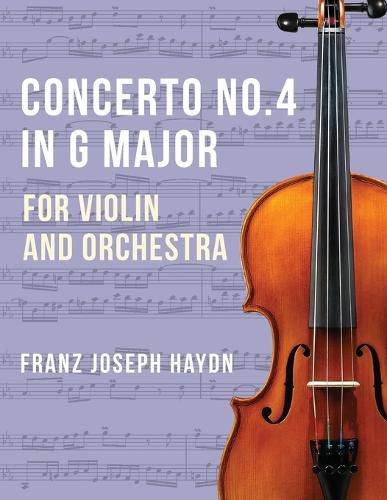Readings Newsletter
Become a Readings Member to make your shopping experience even easier.
Sign in or sign up for free!
You’re not far away from qualifying for FREE standard shipping within Australia
You’ve qualified for FREE standard shipping within Australia
The cart is loading…






This title is printed to order. This book may have been self-published. If so, we cannot guarantee the quality of the content. In the main most books will have gone through the editing process however some may not. We therefore suggest that you be aware of this before ordering this book. If in doubt check either the author or publisher’s details as we are unable to accept any returns unless they are faulty. Please contact us if you have any questions.
Bring This Violin Masterpiece into Your RepertoireHaydn composed four violin concertos during his lifetime, which have become an essential part of the violin repertoire. They are considered masterpieces of the classical era and showcase Haydn's skill as a composer.
The first violin concerto in C major was composed in the 1760s and is believed to be the earliest surviving concerto for the instrument. It consists of three movements, including an opening allegro, a slow and lyrical adagio, and a lively finale in the form of a rondo. The concerto is characterized by its elegant melodies, delicate ornamentation, and virtuosic passages, particularly in the first movement.
Haydn's second violin concerto in G major was composed in the late 1760s or early 1770s. Like the first concerto, it consists of three movements, with a lively allegro as the opening movement, a slow and expressive adagio, and a spirited rondo as the final movement. The concerto is notable for its rhythmic vitality and the contrast between the solo violin and the accompanying orchestra.
The third violin concerto in A major is one of Haydn's most popular works for the violin. Composed in the mid-1770s, it has four movements, including a lively allegro moderato, a tender adagio, a minuet and trio, and a virtuosic finale in the form of a rondo. The concerto is notable for its elegance and charm, as well as its use of ornamentation and virtuosic flourishes.
Haydn's final violin concerto in G major was composed in the late 1780s or early 1790s. It has three movements, with a sparkling allegro moderato as the opening movement, a lyrical adagio, and a lively rondo. The concerto is known for its technical demands and its use of double stops and other advanced techniques.
Haydn's violin concertos are masterpieces of the classical era and continue to be performed by violinists throughout the world. They showcase Haydn's skill as a composer and his ability to write music that is both elegant and virtuosic.
$9.00 standard shipping within Australia
FREE standard shipping within Australia for orders over $100.00
Express & International shipping calculated at checkout
This title is printed to order. This book may have been self-published. If so, we cannot guarantee the quality of the content. In the main most books will have gone through the editing process however some may not. We therefore suggest that you be aware of this before ordering this book. If in doubt check either the author or publisher’s details as we are unable to accept any returns unless they are faulty. Please contact us if you have any questions.
Bring This Violin Masterpiece into Your RepertoireHaydn composed four violin concertos during his lifetime, which have become an essential part of the violin repertoire. They are considered masterpieces of the classical era and showcase Haydn's skill as a composer.
The first violin concerto in C major was composed in the 1760s and is believed to be the earliest surviving concerto for the instrument. It consists of three movements, including an opening allegro, a slow and lyrical adagio, and a lively finale in the form of a rondo. The concerto is characterized by its elegant melodies, delicate ornamentation, and virtuosic passages, particularly in the first movement.
Haydn's second violin concerto in G major was composed in the late 1760s or early 1770s. Like the first concerto, it consists of three movements, with a lively allegro as the opening movement, a slow and expressive adagio, and a spirited rondo as the final movement. The concerto is notable for its rhythmic vitality and the contrast between the solo violin and the accompanying orchestra.
The third violin concerto in A major is one of Haydn's most popular works for the violin. Composed in the mid-1770s, it has four movements, including a lively allegro moderato, a tender adagio, a minuet and trio, and a virtuosic finale in the form of a rondo. The concerto is notable for its elegance and charm, as well as its use of ornamentation and virtuosic flourishes.
Haydn's final violin concerto in G major was composed in the late 1780s or early 1790s. It has three movements, with a sparkling allegro moderato as the opening movement, a lyrical adagio, and a lively rondo. The concerto is known for its technical demands and its use of double stops and other advanced techniques.
Haydn's violin concertos are masterpieces of the classical era and continue to be performed by violinists throughout the world. They showcase Haydn's skill as a composer and his ability to write music that is both elegant and virtuosic.